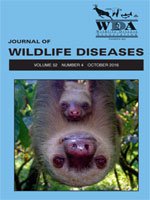We screened for antibodies to 16 arboviruses in four populations of free-ranging sloths in Costa Rica. Blood samples were taken from 16 Hoffman's two-toed sloths (HTSs; Choloepus hoffmanni) and 26 brown-throated sloths (BTSs; Bradypus variegatus) over a 3-yr period. We used serologic assays to detect antibodies against 10 arboviruses previously described in sloths (St. Louis encephalitis [SLEV], Changuinola, Venezuelan equine encephalitis, Ilheus [ILHV], Oropouche, Mayaro, Utinga, Murutucu, Punta Toro, and vesicular stomatitis [VSV] viruses) and six arboviruses not described in sloths (Rio Grande, West Nile [WNV], eastern equine encephalitis, Piry, Munguba, and La Crosse viruses). Overall, 80% of sloths had detectable antibodies to SLEV, 67% had antibodies to ILHV, 32% to Punta Toro virus, 30% to Changuinola virus, 15% to WNV, 14% to VSV, 11% to Venezuelan equine encephalitis virus, and 10% to Rio Grande virus. No samples had detectable antibodies to the remaining eight viruses. We found a significant increase in prevalence of antibody to VSV in HTSs between 2005 and 2007, and for WNV antibody between 2005 and 2006. We found no significant differences in the prevalences of antibodies to the sampled viruses between the two locations. Antibody prevalences were significantly higher in HTSs than in BTSs for SLEV in 2005. Antibody-positive results for ILHV were likely due to cross-reaction with SLEV. The novel finding of antibodies to Rio Grande virus in sloths could be due to cross-reaction with another phlebovirus. These findings might have implications for land management and domestic animal health. Due to the nature of the study, we could not determine whether sloths could represent amplification hosts for these viruses, or whether they were only exposed and could be used as sentinel species. Further studies are needed to fully characterize arboviral exposure in sloths.
How to translate text using browser tools
1 October 2016
SEROSURVEY OF SELECTED ARBOVIRAL PATHOGENS IN FREE-RANGING, TWO-TOED SLOTHS (CHOLOEPUS HOFFMANNI) AND THREE-TOED SLOTHS (BRADYPUS VARIEGATUS) IN COSTA RICA, 2005–07
Scott Medlin,
Eleanor R. Deardorff,
Christopher S. Hanley,
Claire Vergneau-Grosset,
Asia Siudak-Campfield,
Rebecca Dallwig,
Amelia Travassos da Rosa,
Robert B. Tesh,
Maria Pia Martin,
Scott C. Weaver,
Christopher Vaughan,
Oscar Ramirez,
Kurt K. Sladky,
Joanne Paul-Murphy
ACCESS THE FULL ARTICLE

Journal of Wildlife Diseases
Vol. 52 • No. 4
October 2016
Vol. 52 • No. 4
October 2016
arbovirus
Bradypus variegatus
Choloepus hoffmanni
serology
sloth




